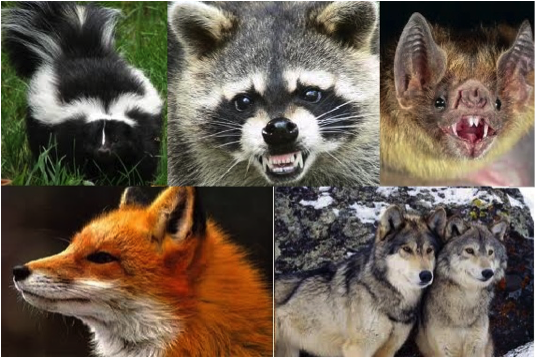The rabies virus is a zoonotic disease that infects animals and humans. Rabies is a disease of the nervous system that can cause behavioral changes, paralysis and death. The principal reservoirs of rabies in the United States are skunks, raccoons, bats, and foxes. Bats and skunks may spread rabies in their saliva without exhibiting symptoms. Any wild animal that allows you to get close enough to handle it should be suspected of rabies and avoided. Dogs should be supervised when outdoors to prevent exposure to rabid wildlife, especially during the night.
Rabies is spread when one rabid animal bites another, introducing the saliva containing rabies to enter the blood stream through the bite wound or any opening in the skin. After entering the body, rabies inhabits the nervous tissue, where it multiplies. Signs of rabies usually begin between about two to ten weeks following infection.
Two Forms of Rabies

Rabid dogs first show changes in behavior like: restless, insecure, or apprehensive, overly affectionate, or shy. Some dogs snap at imaginary objects. Some dogs have a decreaed appetite, fever, or dilated pupils.
Next the dog develops the furious form of rabies. A dog may become particularly restless, wandering long distances while biting and snapping at any moving object. These animals become immune to pain and, if confined, may bite or slash at the bars of their cages. Their voice may change and have trouble eating and drinking from partial paralysis of the vocal cords. Convulsions may be seen and may cause death.
The dumb form of rabies may follow the furious form or may be seen by itself. The dumb form causes paralysis. The dog’s mouth often hangs open, and saliva drips from it. Since such dogs cannot ingest food or water, they become dehydrated. Eventually, total paralysis followed by death occurs.
Vaccination
Recovery from rabies is extremely rare. Animals suspected of being infected are usually euthanized then tested for rabies infection. Dogs should first be vaccinated against rabies when they are three to four months of age.
Protection against rabies is reached within one month after primary immunization. Vaccination against rabies is required by state law, and the same law regulates the frequency of booster vaccination as well. The current recommendations of the Centers for Disease Control vary with the type of vaccine administered.
In general, a booster shot is given one year following the original vaccination, then booster every 1-3 years. .
If you or your dog is exposed to a rabies suspect, that animal should be confined if possible and turned over to a public health officer for rabies quarantine or euthanasia. All bite wounds should be thoroughly washed with large quantities of soap and water and flushed with 70% ethyl alcohol, which kills rabies virus. Whether or not your dog will be quarantined following exposure to a rabies suspect will depend on state and local regulations. However, it is recommended that exposed dogs that are currently vaccinated be revaccinated immediately and confined for observation for ninety days.
Pseudorabies May Mimic Rabies
Pseudorabies, a herpesvirus-induced disease of swine that is fatal when transmitted to dogs or cats, may be confused with rabies infection. Although aggressive behavior has not been reported, the fever, lack of appetite, restlessness, drooling, and self-mutilation that often accompany this disease can look similar to signs of rabies. Since no treatment is successful, the affected animals must be euthanized. Prevent this infection by not feeding your dog raw pork.

